
SUTRI is a normal-incidence solar EUV imager consisting of the following parts:
(1) A Ritchey-Chrétien optical system to image the sun with a field of view of ~Φ41.6' and an aperture diameter of 18 cm;
(2) Normal-incidence Si/Sc multilayers coated on the main and second reflecting mirrors to enhance the reflectivity of the target Ne VII 46.5 nm line with a band width of ~3 nm;
(3) Front (Al) and rear (Al/Mg/Al) filters to suppress the spectral contamination at other wavelengths, especially the strong visible and infrared solar radiation;
(4) Mechanical structures to support the two mirrors, the front filter, the rear filter wheel, the focus mechanism, the focal plane CMOS camera and its electronics box, which are also arranged in a sealed drawtube with a sealed one-shot aperture door to avoid the degradation effects of contamination.
(5) A CMOS camera to record the narrow-band Ne VII 46.5 nm full-disk images. The CMOS sensor is placed in the electronics box including FPGA hardware and flight software to configure the observing parameters and to drive the motion mechanism.
(6) A thermal control system to make sure that every component works at an appropriate temperature.
The main instrumental characteristics of SUTRI are listed in Table 1. A more detailed overview of the SUTRI payload can be found in Bai et al., 2023, RAA.
| Parameter | Value/Mode |
|---|---|
| Entrance aperture diameter | 18 cm |
| Field of view | ~Φ41.6' |
| Spatial resolution | ~8"(~1.22"/pixel) |
| Working line | Ne VII 46.5 nm |
| Formation temperature | 0.5 MK |
| Filter width | ~3nm@46.5nm |
| CMOS detector | 2k x 2k |
| Photon numbers |
Active Region: ~700 photons/pixel/s Quiet Sun: ~135 photons/pixel/s |
| Observing mode |
Routine mode Dark calibration mode Flat field calibration mode Cleaning mode |
| Cadence | Routine mode: 30s |
| Data rate | 15 GB/day |
| Weight | ~30 kg |
| Power | ~30 W (without thermal control system) |